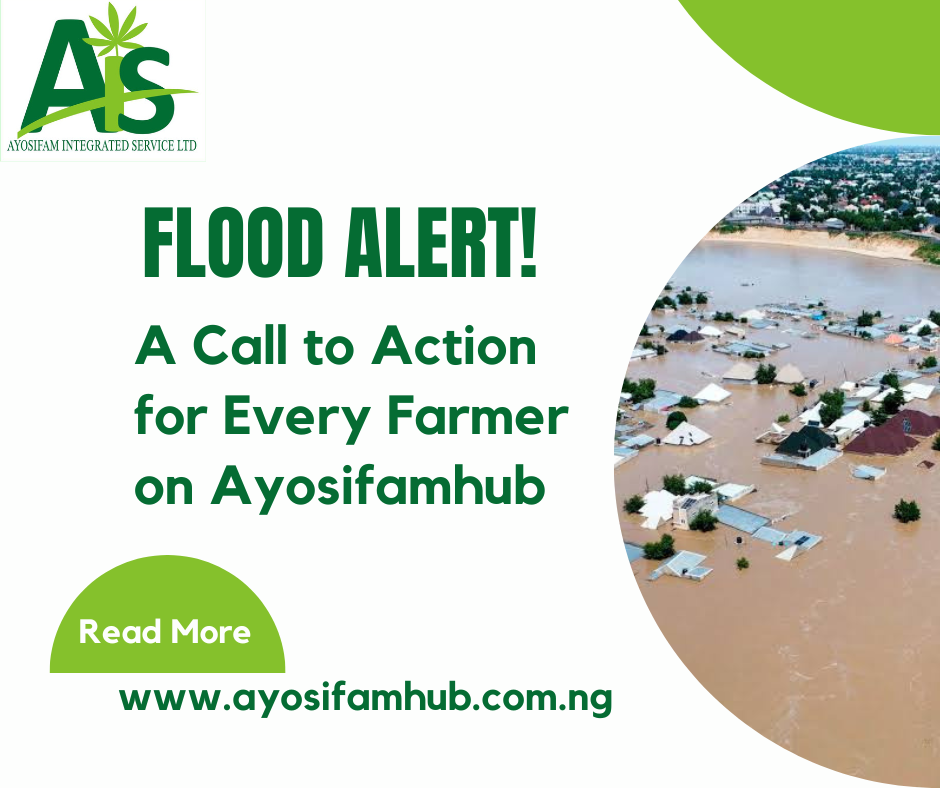Here at Ayosifamhub, our hearts go out to each and every one of you as we hear the latest news from NIMET. They’ve issued a warning: July is bringing floods, and we need to be ready.
We know the worry that can set in when you hear words like “flood” and “farmland” in the same sentence. For many of us, our farms aren’t just a business; they’re our heritage, our sweat, our family’s future. The thought of losing crops we’ve poured our souls into, or seeing our livestock displaced, is enough to make anyone anxious.
But our friends, while we can’t stop the rains, we can arm ourselves with knowledge and preparation. We’ve weathered storms before, and with a bit of foresight and community spirit, we can minimise the impact of these coming floods.
Think back to past rainy seasons. Remember how resourceful we became? That same spirit is what we need now. Here are some thoughts, from one farmer to another, on how we can prepare:
Let’s Be Each Other’s Eyes and Ears
- Stay Glued to the News (and Your Neighbours): NIMET is our official guide, so let’s check their updates regularly. But also, let’s talk to each other! That whisper from a fellow farmer down the road, who has seen these patterns for decades, can be just as valuable. Share information on our Ayosifamhub platform, in our local associations, and even just over the fence.
- Tune In to Your Radio! We know not everyone has constant internet access, but almost every household has a radio. Many local and national radio stations across Nigeria broadcast daily weather reports from NIMET. Make it a habit to listen to these reports – they often provide crucial, localised information on rainfall patterns, flood warnings, and even agricultural advice. It’s a simple, effective way to stay ahead.
- The Wisdom of Our Elders: Our grandparents and great-grandparents faced similar challenges. They knew the signs in the sky, the behaviour of the rivers. Let’s tap into that indigenous knowledge. What did they do in similar situations? There’s a wealth of wisdom waiting to be shared.
Protecting Our Precious Land and Crops
- Drainage, Drainage, Drainage! This is perhaps our best friend right now. Let’s walk our farms, looking for where water collects. Can we deepen existing trenches? Dig new ones? Even simple ridges around our plants can make a world of difference. Think about it like directing traffic for water – we want it to flow away from our precious crops.
- Embrace Resilient Seeds: We’ve seen how some crops stand strong even when others falter. If we’re still planting, or thinking about future seasons, let’s consider varieties known to tolerate more water. Our agricultural extension officers are there to guide us on options like certain NERICA rice varieties. It’s about being smart with our choices.
- The Power of Many (Mixed Cropping): Don’t put all our eggs in one basket, as they say! Planting different crops together means if one struggles, another might thrive. It’s like having multiple streams of income, but for our harvests. Plus, it does wonders for our soil!
- Harvesting with Haste (When the Time is Right): Let’s keep a keen eye on our crops’ maturity. If the forecast is grim, and our crops are ready, let’s not hesitate. Better to harvest a bit early than lose everything to the rising waters. And remember, proper drying is key to prevent spoilage – let’s make sure our storage is up to the task.
- Securing Our Tools and Homes: Our sprayers, our small tractors, our tools – let’s find higher ground for them. If we have animal shelters, can we elevate them? Even simple wooden pallets can lift things just enough to save them from water damage.
Special Notes for Our Potato and Cassava Farmers:
For those of us cultivating potatoes and cassava, these upcoming floods require specific attention due to their vulnerability to waterlogging.
For Potato Farmers:
- Site Selection is Key: Potatoes absolutely loathe waterlogged conditions. If you’re planting or have young plants, avoid areas known to become saturated. Well-drained sandy loam soil is ideal.
- High Ridges for Tuber Protection: If possible, ensure your potato ridges are raised adequately (around 40-45cm high, if feasible). This helps keep the tubers above standing water, preventing rot and disease.
- Drainage Around Ridges: Enhance drainage channels between potato ridges to quickly divert excess water away. Root rot is a major threat when water pools around tubers.
- Harvesting Precautions: If your potatoes are nearing maturity and heavy rains are forecast, consider early harvesting to save as much of the crop as possible, even if it means smaller tubers. Proper drying after harvest is critical.
For Cassava Farmers:
- Mound or Ridge Planting: Cassava is sensitive to waterlogging, especially in its early stages. If you are yet to plant, consider planting your cassava stakes on the top of high ridges or mounds. This elevates the roots and helps them avoid prolonged contact with standing water.
- Improve Soil Drainage: Cassava thrives in well-drained soil. If your land is prone to getting waterlogged, improving internal drainage through practices like zero tillage or, if tilling is necessary, ensuring good soil preparation when the soil isn’t too wet, can help.
- Early Planting for Established Roots: If you planted earlier in the season, your cassava roots may be more established and thus slightly more tolerant. However, prolonged submersion will still be detrimental.
- Watch for Diseases: Waterlogged conditions can increase the susceptibility of cassava to fungal and bacterial infections. Monitor your plants closely for signs of disease.
- Consider Flood-Tolerant Varieties (Long-Term): While progress on highly flood-tolerant cassava varieties is ongoing, research institutions are working on identifying resilient genotypes. For future planning, discuss options with agricultural extension workers who may have insights into better-adapted local varieties.
Our Animals are Family Too!
- High Ground for Our Livestock: If we have cattle, goats, chickens – let’s plan their escape route. Where is the nearest elevated, safe spot? Let’s clear those paths now, before the water rises.
- Safeguard Their Food: Don’t let our valuable animal feed get soaked. Let’s store it in watertight containers, or on high shelves.
Looking Beyond the Horizon (Insurance and Support)
- Insurance – A Lifeline: We know it can feel like another expense, but agricultural insurance can be a true lifeline when disaster strikes. Let’s explore options like the Nigerian Agricultural Insurance Corporation (NAIC). It’s peace of mind, knowing that if the worst happens, we won’t be starting from zero.
- Community Strength: Remember, you are not alone. Ayosifamhub is here for sharing tips, offering moral support, and even helping hands when needed. Let’s strengthen our local farmer groups. In unity, we find strength.
The July rains are coming, and with them, the potential for floods. But we are Nigerian farmers – resilient, hardworking, and resourceful. By taking these proactive steps, by looking out for one another, and by applying the wisdom passed down through generations, we can face this challenge head-on.
Let’s use this time to prepare, to secure our livelihoods, and to protect the food we work so hard to bring to our tables and the tables of our nation.
Stay safe, stay strong, and keep farming!
Your friends and fellow farmers,
The Ayosifamhub Team.




